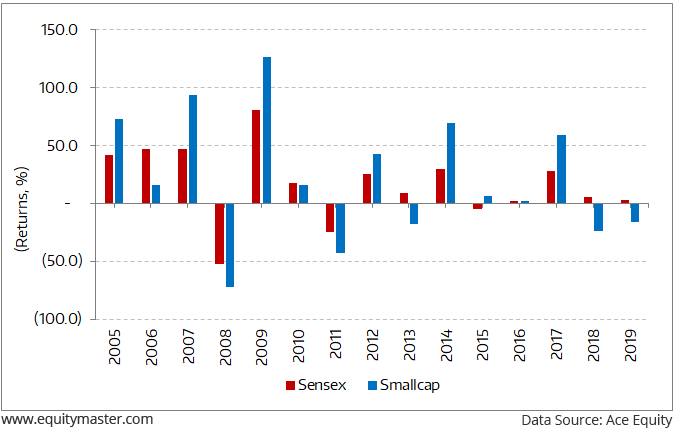India's Third Giant Leap
This Could be One of the Biggest Opportunities for Investors
- Home
- Todays Market
- Indian Stock Market News August 26, 2019
Sensex Trades Over 500 Points Higher; HDFC & Bajaj Finance Top Gainers Mon, 26 Aug 12:30 pm
Share markets in India have recovered from day's low and are presently trading on a positive note. Barring metal sector and auto sector, all sectoral indices are trading in green with stocks in the finance sector, banking sector and realty sector witnessing maximum buying interest.
The BSE Sensex is trading up by 528 points (up 1.5%), while the NSE Nifty is trading up by 147 points (up 1.4%). The BSE Mid Cap index is trading up by 0.8%, while the BSE Small Cap index is trading up by 0.9%.
Speaking of Indian stock markets, if you look at the returns over the years, you will see that the markets have never moved in a linear fashion.
It has never been a one-way street - only up or down.
Stock markets have always moved in cycles.
If you would have bought stocks when either the Sensex or the Smallcap index was in a downturn, you would have made big returns once the cycle turned and the bulls took over.
The Time to Buy Stocks is Now
The economic slowdown does not herald the end of the world or for that matter the end of India. It's a phase and like all phases - This too shall pass.
The real question is - Are you taking advantage of these price declines to buy quality stocks?
In news from the banking sector, shares of public sector banks (PSBs) are witnessing buying interest today after the government announced that it will infuse Rs 700 billion upfront into state-owned banks.
State Bank of India (SBI), Bank of Baroda, Punjab National Bank, Bank of India, and Canara Bank gained around 5% to 12% in early trade today on back of the above news.
On Friday, finance minister Nirmala Sitharaman briefed the media about unwinding and tweaking of measures announced previously in order to address growth challenges. Moreover, she assured that more measures are due to be announced in the next two weeks which will hopefully cheer the market sentiment.
Reports state that the release of Rs 700 billion upfront for PSU banks and other major announcements for easing crisis in non-banking finance companies (NBFCs) will help in credit offtake.
Similarly, allocating Rs 300 billion to National Housing Bank (NHB) will help affordable housing and realty sector. The decision to pass on rate cuts to the borrowers will be a big relief and will help in reducing cost of capital besides boosting credit growth & consumption.
How this pans out remains to be seen. Meanwhile, we will keep you updated on the latest developments from this space.
Moving on to news from the currencies space, China's yuan slumped to a fresh 11-year low against the US$ as the Sino-US trade war sharply escalated, threatening to inflict more damage on the world's largest economies and weigh further on global growth.
The onshore yuan fell 0.6% in early trade to 7.15 per dollar, its weakest since February 2008 and its second biggest one-day drop of the month. The offshore yuan fell to a record low of 7.185 before regaining some ground to around 7.159.
So far this month, the yuan has fallen 3.6% as trade tensions between Beijing and Washington worsened, sparking fears of a global currency war.
On Friday, US President Donald Trump announced an additional duty on some US$ 550 billion of targeted Chinese goods, hours after China unveiled retaliatory tariffs on US$ 75 billion worth of US goods.
China's central bank had been trying to stabilize the yuan in recent weeks after allowing a sudden slide in its value in early August following new US tariff threats.
Meanwhile, the rupee has extended early morning losses and is presently trading at day's low level at 72.19 per US$. The domestic currency opened lower by 32 paise at 71.98 per dollar against previous close 71.66.
On Friday, the rupee fell 15 paise to close at 71.66 against the US dollar on hopes that the government will roll back the FPI surcharge and unveil measures to boost growth.
Note that the domestic currency has witnessed heavy selling in the recent past and has been depreciating against the dollar for the last seven consecutive weeks.
Provisional data with the exchanges showed that FPIs offloaded shares worth Rs 9.3 billion on Thursday. So far this month, overseas investors have pulled out a net amount of Rs 30.1 billion from the Indian capital markets.
Indian rupee became Asia's worst performing currency this month. For the common man, the falling rupee is going to hit where it hurts the most-the pocket.
In the video below, Vijay Bhambwani explains what's behind the fall in rupee and how much can it fall further.
To know what's moving the Indian stock markets today, check out the most recent share market updates here.
For information on how to pick stocks that have the potential to deliver big returns, download our special report now!
Read the latest Market Commentary




Equitymaster requests your view! Post a comment on "Sensex Trades Over 500 Points Higher; HDFC & Bajaj Finance Top Gainers". Click here!
Comments are moderated by Equitymaster, in accordance with the Terms of Use, and may not appear
on this article until they have been reviewed and deemed appropriate for posting.
In the meantime, you may want to share this article with your friends!